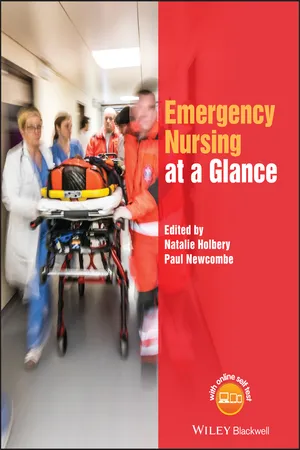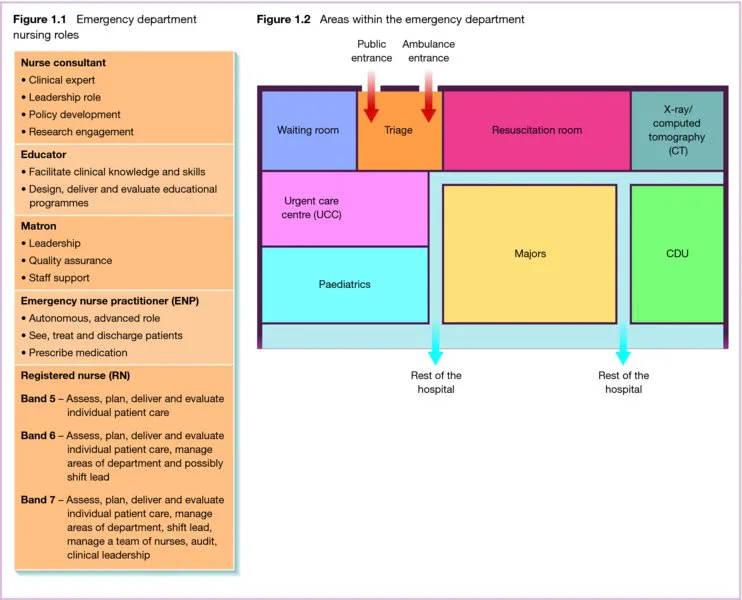The emergency department (ED) is a busy, fast-paced, unpredictable and often highly emotive place to work. ED nurses thrive on the pace, excitement and unpredictable nature of the environment. They need to be proficient in the assessment, recognition and care of patients across the lifespan with undiagnosed illness or injury. They are required to process large amounts of information to facilitate decision making, often in time-pressured situations. Violence and aggression towards ED staff has increased in recent years. Nurses therefore need to be adept at conflict resolution and proficient at communicating with all members of the public. Knowledge of legal and professional issues relating to consent, mental capacity, restraint, information sharing, forensics and end of life care is key to delivering safe and competent care. A number of core and advanced ED nursing roles exist in the UK (Figure 1.1) to ensure that care is delivered safely, efficiently and effectively.
Patients present to the ED day and night, every day of the year. They arrive at the ED in a number of ways (Chapter 2). Current health policy organises services to redirect people away from the ED whenever possible. In the UK, public education encourages individuals to choose the right option to meet their needs. The campaign advises people to access services beyond the ED such as a Pharmacist, a General Practitioner (GP) or a Walk in Centre (WIC) for non-emergency conditions. The majority of patients self-refer to the ED, however others may be referred by a telemedicine service (e.g. NHS 111), a GP, pharmacist or community nurse.
ED team
ED care is delivered by an inter-professional team of nurses, doctors and healthcare assistants. Current redesign of UK emergency and urgent care services has seen an increase in paramedics and physician associates working in EDs. Allied health professionals, such as speech and language therapists, physiotherapists, occupational therapists and dieticians, also work alongside ED nurses to address patients’ physical and social needs as required.
Areas within the ED
EDs vary in size but all are structured to accommodate a variety of urgent and emergency presentations (Figure 1.2).
Triage
Triage is a nurse-led area and usually the first point of contact for patients. It is also known as the ‘front door’ of the hospital. Triage nurses determine the severity of the illness or injury and allocate priority accordingly. Triage is covered in more detail in Chapter 3.
Resuscitation area
The resuscitation area, or ‘resus’, is designed for critically ill and injured patients with high acuity on a triage scale. Examples include trauma, cardiac arrest, stroke, respiratory distress, sepsis and altered conscious levels. This area should be staffed by experienced, specially trained ED nurses with appropriate knowledge, skills and competence.
Majors
‘Majors’ tends to be the core of the ED and is usually the largest part of the department. It accommodates acutely unwell patients with a wide variety of conditions or complaints. Examples include surgical (appendicitis, bowel obstruction, pancreatitis), gynaecological and obstetric (ectopic pregnancy, miscarriage, per vaginal [PV] bleed), oncology (neutropenic sepsis, generally unwell), medical (pneumonia, headache), urology (urinary retention) and mental health presentations. It is usually staffed by core ED nurses. In some departments, emergency advanced nurse practitioners see, treat and discharge patients from majors.
Minors/Urgent care centre (UCC)
‘Minors’ is a term that has been traditionally used to describe patients with lower acuity who are seen in the ED. Recent restructuring of emergency care led to the development of UCCs, some of which are attached to an ED. Regardless of the term used, patients seen in this area of an ED are lower acuity with minor injuries or minor health problems. Examples include limb injuries, epistaxis, cellulitis, eye conditions, back pain, ear, nose and throat conditions, and simple wounds. Minors is usually staffed by core ED nurses, emergency nurse practitioners and doctors.
Children
Children account for approximately 25% of emergency attendances. They and their families should have audio-visual separation from adult patients. This usually includes a separate triage area, waiting room and treatment area. Attention should also be paid to security and child-friendly facilities such as toilets, toys, and food and drink areas. A play specialist is recommended in departments that see more than 16,000 children a year. Registered children’s nurses should be available to care for unwell or injured children. Registered adult nurses will also come into contact with children and their families in areas such as triage, resus and, occasionally, urgent care.
Observation area/Clinical decision unit (CDU)
The introduction of the 4-hour target led to the establishment of areas within EDs aimed at providing holistic care beyond 4 hours. These areas usually consist of hospital beds with single-sex amenities, food and drink facilities, and dedicated ...

